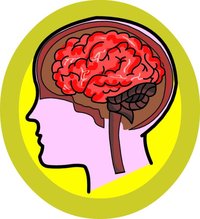Pineal gland
|
|

| Contents |
Location
The pineal gland is a small (8 mm in human) reddish-gray body located above the superior colliculus and behind and beneath the stria medullaris, between the laterally positioned thalamic bodies. It is part of the epithalamus.
The pineal gland is a midline structure and is often seen in plain skull X-rays as it is often calcified.
Structure and composition
The pineal gland consists mainly of pinealocytes, but four other cell types have been identified: interstitial cells, perivascular phagocyte, pineal neurons and peptidergic neuron-like cells.
The pineal body does not have nervous tissue, and consists of follicles lined by epithelium and enveloped by connective tissue. These follicles contain a variable quantity of gritty material, composed of phosphate and carbonate of calcium, phosphate of magnesium and ammonia, and a little animal matter.
Function
It is responsible for the production of melatonin, which has a role in regulating the circadian rhythm. Melatonin is a derivative of the amino acid tryptophan. The production of melatonin by the pineal gland is stimulated by darkness and inhibited by light. Light can be detected by the suprachiasmatic nucleus (SCN) which has direct connections to the retina. Fibers extend from the SCN to the spinal cord via the periventricular nuclei (PVN) into superior cervical ganglia (SCG) and from there into the pineal gland.
In fact, ancient amphibians such as Ichthyostega, which existed in the Late Devonian Period, had an orifice on the top of the skull through which the pineal gland was exposed and received light input. Over the course of time and for unknown reasons, the pineal gland migrated into the skull of later tetrapods and the skull orifice sealed. Modern birds and reptiles have been found to express the phototransducing pigment melanopsin in the pineal gland. Avian pineal glands are believed to act like the suprachiasmatic nucleus in mammals.
It also contains a substance which if injected intravenously causes fall of blood-pressure. It seems probable that the gland furnishes an internal secretion in children that inhibits the development of the reproductive glands since the invasion of the gland in children, by pathological growths which practically destroy the glandular tissue, results in accelerated development of the sexual organs, increased growth of the skeleton and precocious mentality.
Additionally, it has been found that the pineal gland manufactures trace amounts of the psychedelic chemical dimethyltryptamine, or DMT. This endogeous chemical in the human brain is believed to play a role in dreaming and possibly near-death experiences and other mystical states. It has been suggested by the researcher Jace Callaway that DMT is connected with visual dreaming.
Mythology
The pineal gland was the last endocrine gland to have its function discovered. Thus, it was a 'mystery' gland for an extended period. At the same time, its location deep in the brain seemed to indicate that its (unknown) function was important. This combination led to a number of mythologies involving the function of the pineal gland.
Rene Descartes called the pineal gland the "seat of the soul", believing it was unique in the anatomy of the human brain in being a structure not duplicated on the right and left sides. This observation is not true, however; under a microscope one finds the pineal gland is divided into two fine hemispheres.
The pineal gland is occasionally referred to as the "third eye" in occult religions, and the brow chakra in yoga, and is believed by some to be a dormant organ that can be awakened to enable telepathic communication.
Anatomy Clipart and Pictures
- Clip Art (https://classroomclipart.com)
- Anatomy Illustrations (https://classroomclipart.com/clipart/Illustrations/Anatomy.htm)
- Anatomy Clipart (https://classroomclipart.com/clipart/Anatomy.htm)
- Anatomy Animations (http://classroomclipart.com/cgi-bin/kids/imageFolio.cgi?direct=Animations/Anatomy)

